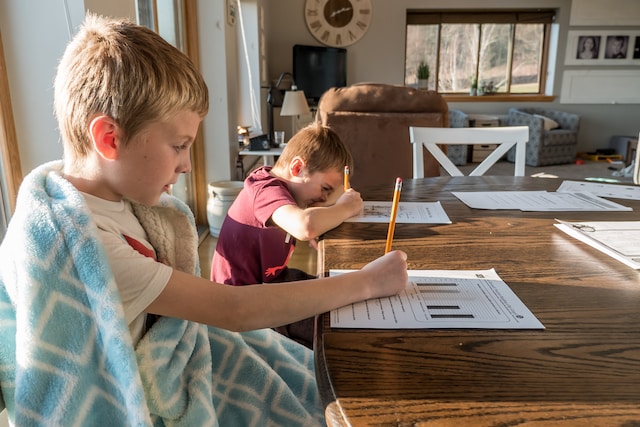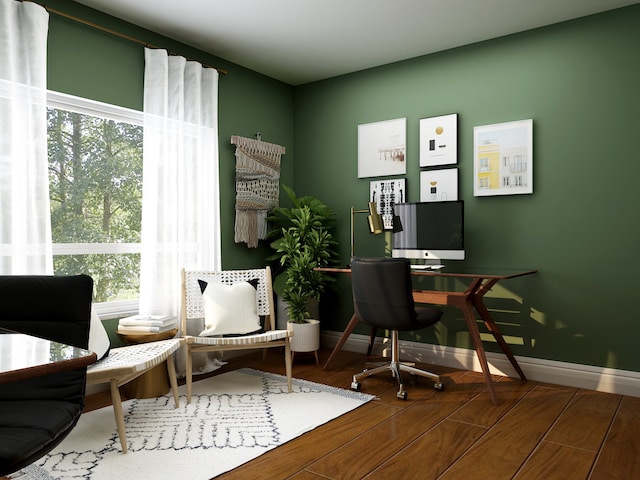Many parents nationwide have chosen to homeschool their children rather than place them in a traditional school environment. According to the National Home Education Research Institute, approximately 3.1 million students in grades K-12 were homeschooled in the 2021 through 2022 school year. That’s an impressive six percent of the entire school-aged population. There are many reasons why parents might opt for homeschooling, whether they’re unhappy with their public schools’ curriculum or they live in a rural, remote area. Whatever the reason, it’s important that parents know how to create a safe homeschool environment that healthily fosters learning and support. This guide has plenty of helpful tips for parents to create a safe and inclusive environment at home. It covers the basics of homeschooling and information about how to design an appropriate learning space, key safety considerations, and how to support sensory-sensitive and autistic children. You’ll also learn how homeschooling impacts your home insurance, so read on to learn more.
Understanding why parents choose a homeschool environment
There are many reasons why families may choose homeschooling as their educational approach. Some of these reasons may include:
- Concerns about the traditional school environment, including bullying, drugs, general safety, or peer pressure
- Some parents may want more control over the moral and ethical values their children are taught
- Dissatisfaction with the public or private school curriculum
- Families with children who have special needs
- A desire to offer children a more religious-focused education
- Some families want to keep the family unit closer together, so homeschooling is a good option
Teaching at home provides a wide range of benefits for children, particularly the opportunity to give them a more personalized learning experience. Certain public schools may offer a different type of curriculum than parents prefer their kids to learn. If you’re a family who travels a lot, homeschooling also makes it much easier to have a flexible schedule that adapts to your lifestyle. And for children with special needs, it helps to give them a safe space where they can learn at their own pace.
Unfortunately, there are many common myths and misconceptions about homeschooling. Here are some of the things that people may believe about the homeschool environment and the choice for parents to teach their kids at home:
- Some people believe homeschooling is only performed by deeply religious families, but statistics show that most families opt for a secular curriculum at home.
- Many think homeschooling prevents kids from socializing and that it may stunt their “social growth” and ability to adapt to the real world. However, there are many extracurricular programs for homeschooled kids where they get to play sports and socialize with other children in their age group.
- One common misconception is that homeschooled children don’t go to college. However, a large percentage of students who are homeschooled go on to attend a four-year university.
Helpful homeschooling resources and materials

When teaching your kids at home, having the right resources at your disposal is important. Many materials and other resources are available that will help make the experience smoother and easier, not just for the students but also for the parents (teachers).
- Curriculum options: Parents have several curriculum options to choose from. The most popular options include the Waldorf method, Montessori, and Charlotte Mason. The Waldorf method focuses on the student’s whole self, including the head, heart, and hands, aiming to find a balance between logic, emotions, and experience. The Montessori method allows students to learn at their own pace and gives them the freedom to choose what they want to learn as well as how. This method uses hands-on learning first and foremost. The Charlotte Mason method encourages students to develop new ideas and habits that will stay with them forever. It puts a focus on enrichment through nature and high-quality literature.
- Textbooks: Many books are available for a homeschool environment, depending on the student’s age and grade level. Homeschoolers can go online to find plentiful resources, including a wide range of reading lists designed to teach students of each grade level and group.
- Online tools: Homeschool teachers can utilize many resources online, including software that creates interactive lessons, real-time testing, and more. Khan Academy provides a variety of curriculum that integrates instructional, educational videos, and more. A service called Prodigy gives students the help they need to learn mathematics via online learning, while Duo Lingo teaches foreign languages.
If you need resources and tools on a budget, consider doing a textbook swap or purchasing used books instead of new ones to help you save money. There are also plenty of websites that provide a plethora of printable worksheets, tests, and more. Look for local homeschool groups where you can share resources and buy or sell supplies at a discount.
Designing your ideal homeschool environment
Before you begin homeschooling your child, creating the ideal learning environment is essential. Here are some tips to help you with child safety and ideas to ensure your new homeschool environment is designed for educational purposes.
Select the ideal location
Consider the following factors when you’re choosing a suitable location within your home for the homeschooling environment:
- Quiet and distraction-free: Choose a space as far away as possible from noisy areas and distractions like traffic, people walking by, and everyday distractions like the television. Consider adding soundproofing to the room if there’s too much outside noise. You can also add noise-blocking curtains to windows in the learning space if the exterior sounds are an ongoing concern.
- Natural light: Select a room with ample natural light whenever possible. This will help to create an inviting, energizing atmosphere. Position computers so that they don’t get glare from the windows during learning hours. Supplement the natural lighting with task lighting like desk or floor lamps with an adjustable head for versatility.
- Accessibility: Make sure the homeschooling space is easily accessible and comfortable for parents and children. Choose a room you can easily access at any time of the day, in an area of the home you can get to whenever you need to.
If you don’t have a spare room in your home, consider converting a part of your living room, dining room, or a corner of your child’s bedroom into a dedicated learning space. A room over the garage is also an excellent option, with adequate light, ventilation, and heating/cooling.
Tips for organizing a productive learning environment

After you choose the right location, it’s time to focus on organizing the new space as efficiently as possible:
- Storage Solutions: Add storage options like cabinets, shelves, and bins to help you keep all of your educational materials, including books and supplies, neatly organized and easily within reach. Label storage bins clearly so your student can find what they need quickly.
- Desk or Workstation: Bring a comfortable desk or a workstation and pair it with an ergonomic chair to encourage good posture during educational lessons and study time. Make sure the desk has plenty of storage so your child can keep essential school supplies close at hand.
- Personalization: Encourage your child to personalize their learning space by letting them hang artwork, posters, or motivational quotes to keep them inspired. You can even let them paint the space their favorite color.
When you organize the homeschool space, consider your child’s age and preferences. Younger kids may prefer a more open, play-based setup, while older students may need a quiet area with minimal distractions.
Ways to create a more engaging homeschool environment
There are several things you can do to make the homeschooling environment engaging and conducing to learning:
- Learning Materials: Ensure that textbooks, workbooks, and educational resources are interactive, fun to read, and easily accessible. Always make sure you’re choosing age and grade-appropriate learning materials. Change things up by mixing traditional lessons with fun and interactive learning experiences.
- Interactive Learning: Incorporate interactive elements in the space like whiteboards, corkboards, screens for digital educational films, and educational posters. Incorporate hands-on activities like art projects and science experiments to make learning fun.
- Inspiration Station: Set up an “inspiration station” that includes interesting books, a variety of art supplies, and educational games that encourage curiosity and creativity. Use educational toys for younger students so that they’re learning something while remaining engaged.
Remember that it’s important to maintain a learning schedule so your child knows when to focus on schoolwork. Come up with a schedule you can agree on and write it on a large whiteboard or corkboard. Make sure your child wakes up at the same time each day so that they’re accustomed to getting ready for school, even if it’s at home.
Incorporate flexible learning zones when homeschooling

Since homeschooling involves a variety of subjects and activities, consider setting up distinct learning zones within your homeschool environment:
- Quiet Reading Nook: Dedicate a cozy corner for quiet reading and reflection, and add a comfortable chair, a small side table, and a floor lamp. Keep the bookshelf nearby and stock it with many books based on your child’s reading and grade level.
- Science and Exploration Zone: Set up a dedicated space for hands-on science experiments and lessons or nature exploration. Keep all of your scientific supplies neatly organized and labeled so they’re easy to find, and make sure you’re using the proper protective equipment if you’re working on chemistry experiments.
- Art and Creativity Area: Designate an area where your child can express themselves through the artistic and creative process. Include an easel, canvases, paints, sketchbooks, colored pencils, and other art supplies.
Aside from designating some flexible learning zones, consider taking your child on educational field trips. It can be a visit to a local art or science museum, a trip to the theater, or a meetup with other homeschooled students so that they have an opportunity to socialize.
Special care tips and help for sensory-sensitive and autistic children in your homeschool environment
Homeschooling allows parents to offer a tailored educational experience for children with sensory sensitivities or autism. Remember to adapt to your child’s needs based on their condition and grade level. Here are a few things you can do to ensure that you’re creating a sensory-friendly homeschooling space:
- Sensory-Friendly Design: Incorporate things that will make your homeschooling area friendly to sensory-based needs. Use calming colors, keep the space organized, reduce clutter, and add sensory tools like fidget toys and noise-canceling headphones. Not only will this promote a calming environment, but it will also make it easier for your child to learn and stay focused. Keep a trashcan and cleaning supplies close by so the homeschool environment remains clean and organized.
- Flexible Learning Options: Offering flexible learning options to your child will make homeschooling easier. For example, allow sensory breaks when your child needs them, and be open to flexibility by providing different learning styles based on your child’s unique needs. Homeschooling allows parents to be much more flexible with their choice of teaching methods so that they can find the right balance that works best for their child and their unique needs.
If you have autistic learning at home, remember these tips to help you create a conducive learning environment and experience:
- Structured Schedule: Creating a structured daily schedule provides autistic children with a sense of security, predictability, and safety. Create fun visual schedules that are easy to read, and use timers to help your student cope with the transitions between lessons or daily tasks. While your schedule should be fairly rigid, the learning method can be flexible. Allow your child to lay on their stomach, use a weighted laptop desk, or use noise-canceling headphones if it helps them deal with sensory issues.
- Sensory Breaks: Incorporate sensory breaks into your daily homeschool routine. This allows for regulation opportunities that will help your child focus. These breaks also enable autistic children to recalibrate and relax to help reduce pressure and stress. A weighted blanket can help children feel calm and centered while learning and a sensory swing helps them self-regulate in the home classroom.
In addition to accommodating sensory-sensitive and autistic children, it’s equally important to consider the unique needs of children with Attention Deficit Hyperactivity Disorder (ADHD) in your homeschooling environment. Children with ADHD often struggle with concentration, impulse control, and hyperactivity, which can pose challenges in a traditional classroom setting. Here are some tailored care tips to create an adequate homeschooling space for children with ADHD:
- Structured Routine with Flexibility: Much like autistic children, children with ADHD benefit from a structured daily routine. However, allowing for flexibility in their learning schedule is also crucial. Create a visual schedule with clear time blocks for various subjects or tasks, but be ready to adapt when your child’s attention wanes. Short, frequent breaks can help them recharge and refocus.
- Multi-Sensory Learning: Incorporate multi-sensory teaching methods to engage children with ADHD effectively. Use hands-on activities, interactive learning tools, and visual aids to make lessons more engaging. These methods can help hold their attention and cater to their various learning styles.
- Minimize Distractions: Reduce distractions in your homeschooling space. ADHD children are easily distracted, so a clutter-free, well-organized environment is essential. Consider noise-canceling headphones or a designated quiet area where your child can escape sensory overload when necessary.
- Individualized Learning: ADHD is a highly individualized condition, and what works for one child may not work for another. Pay attention to your child’s specific needs and preferences. Some children with ADHD find it helpful to stand while working or to have access to fidget tools, such as stress balls or kinetic sand, to channel their excess energy.
- Break Tasks into Smaller Chunks: Divide lessons and assignments into smaller, manageable portions. Children with ADHD can become overwhelmed by lengthy tasks, so breaking them into smaller chunks makes the work more digestible and less intimidating.
- Patience and Positive Reinforcement: Children with ADHD may struggle with impulse control and staying on task. Be patient and use positive reinforcement strategies. Praise and reward your child for completing tasks and maintaining focus. This can help motivate them to stay on track.
- Physical Activity: Incorporating short bursts of physical activity or exercise throughout the day can help children with ADHD release excess energy and improve concentration. Consider including short exercise breaks between lessons or as a reward for completing tasks.
Remember, the right homeschool environment will provide a nurturing and adaptable place that allows you to focus on your child’s unique strengths and challenges to help them grow and improve.
Vital safety considerations for your homeschool environment
Aside from choosing your space, schedule, and curriculum, there are several things you should do to promote safety in the homeschool environment. Keeping your child safe will ensure their confidence and security throughout the homeschooling process. Incorporating childproofing measures like adding child-safe electrical outlet covers and using straps to tie furniture to the wall is crucial, especially for younger children. Here are some tips to help you address various safety hazards and the precautions you can take.
- Tall bookshelves are prone to tipping over, so use low-profile bookshelves that are waist-high instead so that everything is easily within reach. Never place extremely heavy items on the top of bookshelves.
- If your classroom has hard surface floors, add area rugs secured with special rug tape or a grippy bottom, so they don’t slide around and cause an injury.
- Don’t overload electrical outlets. Instead, use a surge protector or a power strip, or only plug-in electronics when needed, then unplug them when the school day is over.
- Never leave young children unattended in your homeschooling classroom.
- Make sure that the windows in your classroom have locks if you’re on the second floor, and keep them locked unless you’re present.
- Check all of the chairs and other seating in your classroom to ensure that they are put together securely and that all seating is stable and in good condition.
- Always follow the proper safety protocols when you’re conducting science experiments or working with any type of chemicals. Dispose of these chemicals properly and immediately after you’re done using them.
- Consider consulting with a professional tutor if you need help performing certain lessons so your child can participate in them safely.
- Avoid eating and drinking in the classroom whenever possible. This will not only keep your homeschooling space clean, but it also prevents spills, which could result in slips and falls. Designate a separate area in the home, such as the kitchen or dining room, for snack breaks and lunch.
How your homeschool environment may affect home insurance

Homeschooling your child can impact your home insurance policy in several ways:
- Liability Concerns: When you homeschool, you may have more people visiting your home regularly, including tutors, co-op members, or fellow homeschool teachers and students. This will increase foot traffic, which may affect your liability coverage, potentially increasing the risk of an accident or injury on your property.
- Property Coverage: When homeschooling, you’ll likely need to use additional equipment, such as computers and a range of educational materials and supplies. Check with your home insurance company to ensure your property coverage limits protect these valuable assets. You may need to raise your limits to ensure that these items are covered under your plan in case of a fire, theft, or natural disaster.
- Home Modifications: If you have significantly modified your home to create a designated homeschooling space, it may impact your home insurance policy. Adding electrical outlets, building an addition to your home, or installing built-in shelving could affect the amount of coverage you need.
Practical steps homeowners can take to address insurance concerns
If you’re concerned about your current home insurance policy, keep these tips in mind to make sure that you’re covered:
- Review Your Policy: Take some time to review your current insurance policy with your provider. Ensure that it adequately covers all of your homeschool-related activities, as well as your policy’s liability limits, homeschooling equipment you’ve purchased, and any significant changes you’ve made to your property. If you feel your current policy is insufficient, talk to your insurance agent or your insurance company’s customer service department to update it to something more comprehensive.
- Additional Liability Coverage: Add an umbrella liability policy to your current home insurance plan. This will provide you with extra protection just in case of an accident or injury related to your homeschooling activities. This coverage aims to protect you if you are involved in a lawsuit and should also cover any medical expenses that a person incurs if the incident happened in or around your home.
- Inventory and Documentation: Always keep thorough records of your homeschooling-related expenses, including equipment, furniture, supplies, and home modifications. This information can be extremely valuable if you ever need to file a home insurance claim resulting from damage or theft. Not only should you keep paper records and receipts, but it’s also a good idea to take photos of the items you’ve purchased and store all of your records electronically if you ever need to access them remotely.
There may be many reasons why you’ve decided to homeschool your child, whether it’s because they have special needs or you prefer more control over the learning process and environment. If this is something you have decided to pursue, always remember to prioritize the education your child receives and their safety and well-being as a whole. Review your home insurance policy regularly to ensure you have the coverage you need throughout your child’s homeschooling years. With these tips in mind, you’ll be able to create a homeschool environment that’s safe, fun, and exciting so that your child will receive the well-rounded education they need to succeed.




